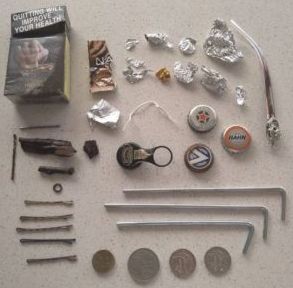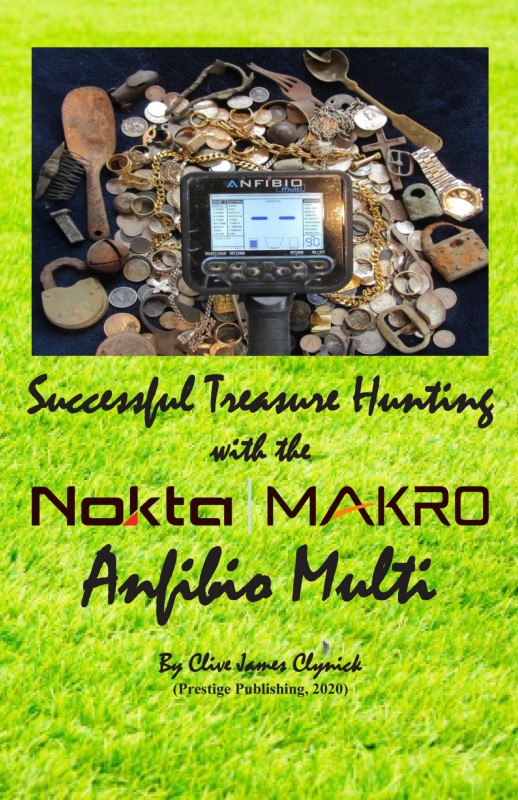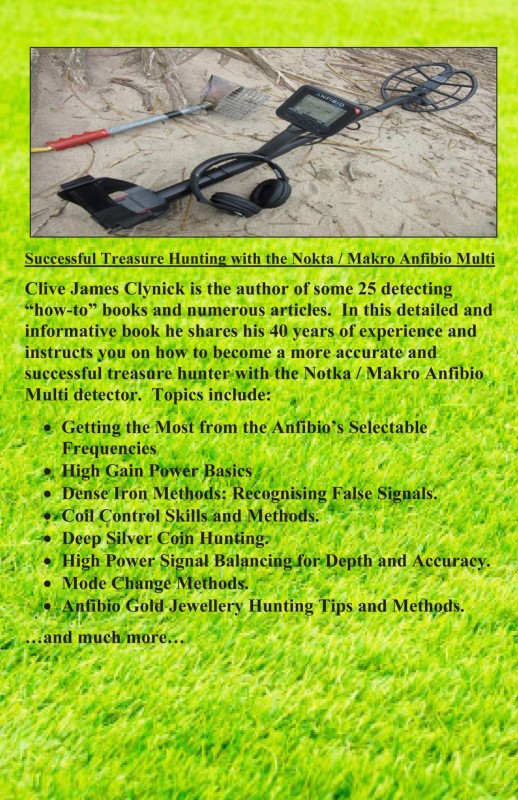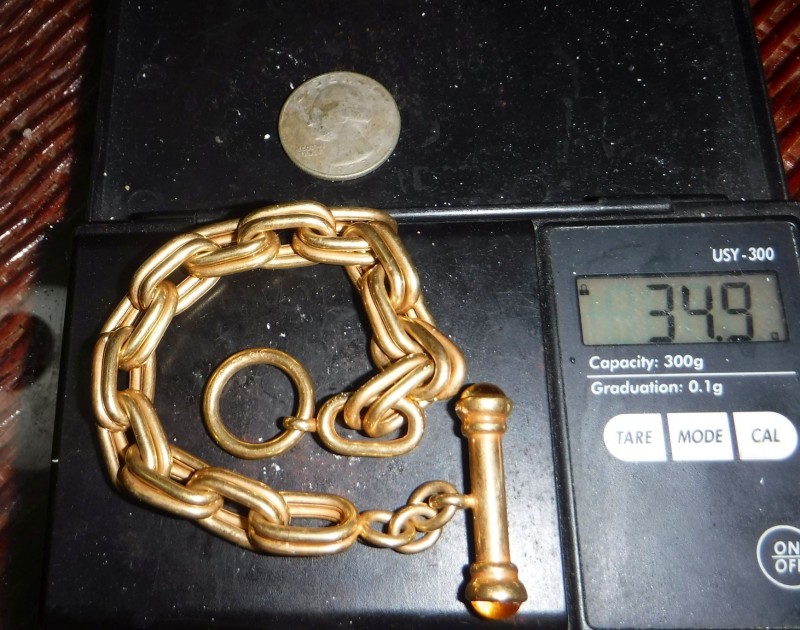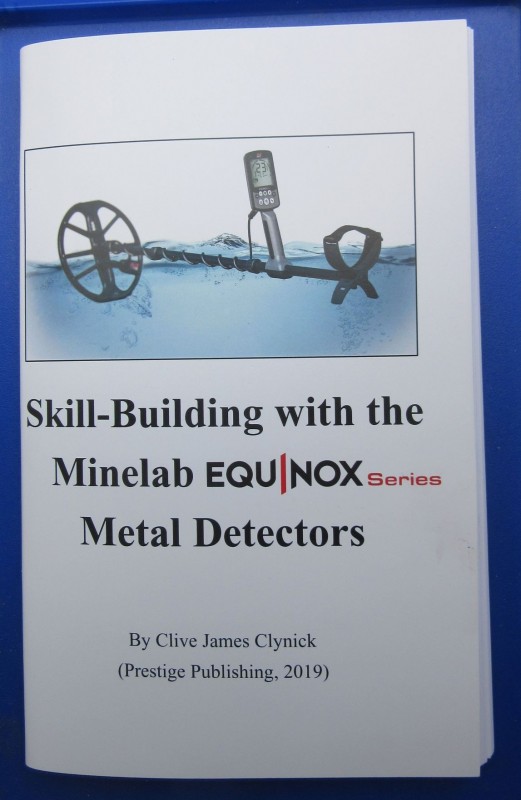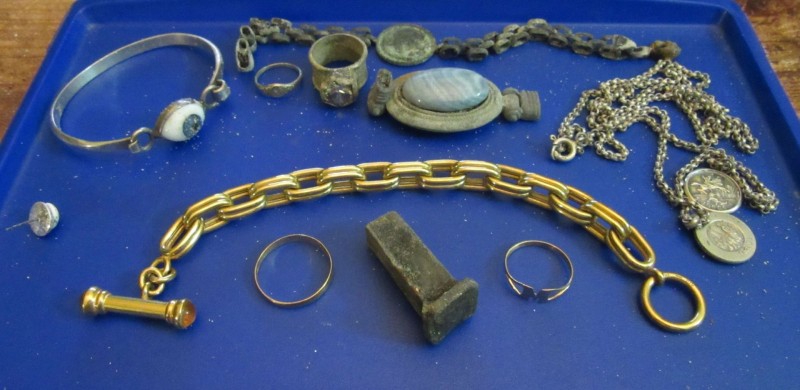-
Posts
514 -
Joined
-
Last visited
Content Type
Forums
Detector Prospector Home
Detector Database
Downloads
Everything posted by cjc
-
I see way too many new hunters who hope to find some gold but think it’s the first thing they are going to find..sorry bad news–its not In most conditions, random digging is not going to do much for you. While its good to dig a lot of targets, the key is to continually work on your selectivity. By all means the way to get used to the target sounds of your detector is to to dig but along with this learning over time it’s important to be able to recognize some various basic target types. In the picture we have a nice array: too big–(cigarette pack), elongated: (Allan keys, glasses arm and bobby pins). too small and weak: (some of the smaller foils at left),, alloys (caps). Not shown here are some iron targets–(bolts, that type of thing). With practice these are all recognizable targets–they have “problems” either on the meter or when checked on the cross sweep or in pinpoint. “There are also several “good” targets–a few coins, and some of the more solid foil pieces. While it might not be as exciting as getting out and digging–just getting a few of each target type and testing them on an upside down cardboard box can increase your accuracy a lot. While there are sites where “inclusive digging” is the way to go–remember–an exception does not make a rule. Learning how good targets respond is a more productive way to learn than “going begging” with weak, elongated or out-sized signals. The “iffy” ones can come later. clivesgoldpage.com
-

Selectable Frequency And Multiple Frequency
cjc replied to Steve Herschbach's topic in Metal Detector Advice & Comparisons
Thanks for your great, thorough article, Steve. Really filled in a lot of gaps in my history files. This kind of theory is important to know so that people don't expect too much from any single platform. They all do different things well. Lets hope you are right about the do all" models to come. cjc -
Thanks Redneck. Turns out you DO know your....Sorry-- Ya those are great phones perfect impedance match--they make a great detector near perfect--especially in the iron way fewer spike digs. Glad you are enjoying the book. Kind Regards clive
-
Just got a set of these shipped in 3 days from Hungary. Perfect impedance match for the N/M detectors--incredible sound. Very clean and sharp --brings my accuracy up a lot. They are so loud they need to be run at 8. I worked with the manufaturer to improve his strain relief system (see the Heyco)--very nice set of phones for these machines. cjc
-
2/ The Anfibio’s Strengths: Audio Every Nokta / Makro detector I try seems to have better, cleaner, more informative audio than the last. The Anfibio is also what would be termed a “high bias” detector in that when you learn to listen for extension in the response--you can become very accurate. This sharp, clean audio lets you hear a real lot of detail about what is under the coil. There are several U.K. “YouTube” videos out of hunters placing nails right on top of coins and still being able to detect the coin with the Anfibio. This is a great demo of just what this machine’s fast processing speed and high-bias performance can do for your find count at old sites. I credit the operating characteristics of Nokta /Makro detectors with teaching me how to effectively use coil control target testing. This has found me a lot of deep gold and silver. With the speed and “clean” metal bias of a machine like the Anfibio this testing is much more effective--that is, when you use the coil to check a signal by going to the “cross-sweep”--iron and other corroded targets don’t “stay in.” Misshapen objects like scrap lead or “can slaw” are also more likely to give a broken tone. Again, good, non-ferrous responses have “extension.” What I learned was that there’s a whole other level of skill building, accuracy and effectiveness available to you with this clean audio and super-fast signal processing. Other strengths of this detector include a great display that lets you make fast adjustments for more exact tuning or “ID-ing” This also lets you jump from mode to mode instantly to cross check responses. You can move between different frequencies (5, 14 and 20 kHz), audio modes, and recovery speeds in an instant. There’s also a versatile Discriminate package that lets you manage your target selection with accuracy. This also a very deep and powerful detector with great small object sensitivity. The reason for this is because the Anfibio features high Gain circuitry. Gain acts to sample a tiny part of the returning signal and amplify it. This small sample is easier to manage in software and more of the distortion can be removed. So you have a cleaner, deeper signal. This means that small targets are amplified (or boosted) as they are received. Like many detector features--this is a “two-edged sword.” While small and deep responses are brought up to where there can be heard, other non-so good signals that are just across the “line” into the iron range are also amplified and may be “pulled up” to mimic good signals. For the beginner, this can be confusing as iron targets and even a few foils and crown caps are “hopped up” and may indicate as coins. However, the good news is that once you learn a few simple basic “fixes,” the downside of this tradeoff about disappears and this extra deep object punch becomes your best weapon. This takes practice, bench testing and time in the field. You could call the Anfibio a “Gain heavy” detector in that even at the presets-there will be good sounding false signals--from spikes, deep iron and some bottlecaps. As will be detailed further on--a good beginner strategy is just to “turn it down” and do some familiarization in 2 Tone audio mode. Even running at a Gain setting of “55” or “60” is a not a bad idea. This simplified less “amped up” audio will respond to these falses in more recognizable ways. An intermediate stage is to have one search mode with preset or higher Gain and a second weaker setting--to see how signals respond with less Gain. Going between the two is a great way to really get a feel for how Gain goes deeper--but at the same time brings with it considerable distortion. Targets sound fuller and better at high Gain settings. Where you see a response disappearing completely --or becoming broken in the low “checker” mode--suspect iron. Where a target just becomes weaker--this has a better chance of being a good, non-ferrous target. Gain also acts to “fill out” small responses--making them sound bigger, fuller and better. This makes for what I’ve heard termed a “steep learning curve” for the novice as there is the urge to go after a lot of sounds that are too small to be good targets. What helps is to gather more information than just “meter and tone” using the coil and the Pinpoint control. This lets you place your signals in context--to focus on the size, shape and location in the strata of each signal. When you learn to do this--each signal feature acts to confirm the others--giving your accuracy and conclusiveness a huge boost. For example there is nothing better than hearing a high silver tone, seeing a “92” on the meter and then getting the confirming narrow Pinpoint response that indicates a non-ferrous object. I call this the “In Keeping” method. (More on this later). Another effect of high Gain circuitry is that the detector is more likely to sound off on unusual variations in the ground. These can be patches of black sand or anything that represents a big change. So the ends of spikes, twisted wire or aluminum shards can all “sound off” on your first coil pass. This is where Another great thing about the Anfibio is its stability. Where there is not much interference from electrical sources it’s possible to run this detector at almost coil control comes in in that these are not consistent targets and will change or disappear on the cross-sweep or with varied coil passes. Where there is not much interference from electrical sources it’s possible to run this detector at almost full Gain.full Gain. However this type of setting has a downside too in terms of the false signals that it brings up. This is where learning some of the basic skills covered in this book can be of help--letting you mediate this high power with accurate signal type recognition and checking methods. Even where you do have a lot of interference--it’s possible to run a “balanced” signal so as to be able to hear good targets though the noise. From:"Successful Treasure Hunting with the Notka / Makro Anfibio Multi Metal Detector. by Clive James Clynick Reviews at: clivesgoldpage.com
-
Totally agree, Monster. Going from the specific (settings, for example) to the general doesn't work. To be versatile and have consistent success needs a broad set of skills. These skills will help you under any conditions--instead of trying make "one size fit all". When you have some solid complete definitions in hand (modulation, gain, iron bias for example), and basic skills to apply these features any set of conditions will be easier to figure out. There's no such thing as "push button detecting"--contrary to what the companies would have us believe. cjc
-

Anfibio Book Excerpt - Below Zero Accepts
cjc replied to cjc's topic in Nokta / Makro Metal Detectors
-
I'm proud to announce my new book on the Anfibio Multi. Had this detector in at some of the worst most iron infested truck grove sites around last year and did really well--wanted to share some of the things that have worked well for me. cjc Successful Treasure Hunting with the Nokta / Makro Anfibio Multi Clive James Clynick is the author of some 25 detecting “how-to” books and numerous articles. In this detailed and informative book he shares his 40 years of experience and instructs you on how to become a more accurate and successful treasure hunter with the Notka / Makro Anfibio Multi detector. Topics include: · Getting the Most from the Anfibio’s Selectable Frequencies · High Gain Power Basics · Dense Iron Methods: Recognizing False Signals. · Coil Control Skills and Methods. · Deep Silver Coin Hunting. · High Power Signal Balancing for Depth and Accuracy. · Mode Change Methods. · Anfibio Gold Jewelry Hunting Tips and Methods. …and much more…
-
18/ Understanding “Below-Zero” Accepts I take this term from the language used with the first programmable, digital machines that came onto the market in the 1980’s. These set a benchmark for all others since. Part of the reason for this was because although they balanced out mineralization in the ground, they also examined the iron in the ground to see if there were targets mixed in with it. If you can imagine a scale of minus 100 to plus 100 with “0” being the line between non-ferrous and ferrous, these machines used “below zero accepts”. By this I mean that they were pre-set to examine part of this iron range (usually the first “30”increments) instead of just knocking it out. This created much better depth (by the standards of the day). These machines also had the ability to pick targets from amongst this iron--by hearing it too rather than just suppressing it. This is also the Anfibio’s strength--but with much more overall sensitivity. So what you have with the Anfibio is a very sophisticated level of filtering and processing that: • -first, gathers a full and very detailed picture of what is under the coil.• -then filters this diverse signal down to sort the (quick-responding) consistent parts from the (slow-responding) less consistent ones. This broad, detailed initial “look” at the ground means that the detector can separate out small, deep objects as well as those that are in very close to iron very effectively. In effect the Anfibio is “reaching” down into the iron range to give the machine more detecting power. This also means that desirable targets that are coming in partly within this range are more readily detectable. Things like stainless watches, corroded targets such as long buried brass also respond better than with other machines. The “trade-off “here is that the line between ferrous and non-ferrous is blurred. This is true of all high Gain detectors. Things like round bolts and some of the more solid iron objects can jump up to overwhelm the discriminate circuit. So you have a “two edged sword.” Where you want to get better responses from low conductors such as gold chains and earrings--you can run a lower discriminate and / or first Tone Break. However, when you do this--more iron, steel (such as bobby-pins), and other weak conductors will respond. Rather than an actual ferrous / non-ferrous line, what you have is more like a “firewall”--and as you bring the Discriminate and first Tone Break up--this “firewall” is made thicker. Learning to manage this “rust line” is a very important skill that will let you select targets with more accuracy and stabilize the unit at high Gain settings. A low Discriminate / Tone Break setting opens the machine up to more of this “below zero” range. This comes through in the form of “crackle” and other falses. A higher setting creates a bigger reject block between the two (plus and minus) “sides.” Understanding this--and being able to choose a correct setting is the essence of running a balanced signal--distributing the unit’s power evenly and—by standard, quietly. It’s important to recognize the fact that what a detector does is not to just punch down into the ground and alert on metal. Instead--as described above--it acts to separate ground from metal. What this means is that the iron and ground’s responses form part of the signal. A good way to understand this is to think of all metal signals as being a “peak” in the larger ground’s signal. The more of this low range you want to inhibit (block off)--the fewer targets will be available. (For hunters interested in re-working “hunted out” type sites--opening up this low discriminate range is another option that can be combined with a slow recovery speed (Deep mode) or a faster one (3 Tone) or targeted hunt methods using one of the three Frequency options). Remember--it’s not depth that obscures targets--it’s the surrounding “noise.” The more of this “noise” you are prepared to learn to “hear though,” the more you will find. Alternately--creating a wider, more solid bottom reject block can also reduce noise--allowing targets to “jump” though as with the Beach mode’s high Discriminate setting of “15.” This type of setting can be used either to bring the machine’s processing up above the noise level of difficult ground or salt sand, or to reduce the noise of dense iron and bring up masked signals. From: "Successful Treasure Hunting with the Notka / Makro Anfibio Multi Metal Detector" by Clive James Clynick (Prestige Publishing, 2020
-

Fisher Impulse AQ Book Or Manual
cjc replied to pinpointa's topic in First Texas - Bounty Hunter, Fisher & Teknetics
By who? (lol).... cjc -
My CTX had been in the shop for quite a while–it had the old config and leaked more than once. One bulkhead, one set of clips and two lithium cells later she was still drinking brine. Thanks to Minelab I’ve just gotten a like new machine and am very excited and grateful. (This must be what it’s like to complete a jihad and be granted a virgin in the afterlife)! Anyhow, I do a lot of testing in my basement in that the interference from furnace, household panel and dryer simulate actual tough salt surf conditions. If you can tune a detector inside–you are doing something right. This is especially true of big coils. I have the large coils for my CTX, Equinox 800 and a WOT hardwired for my Blue Tubes Excal. There is a ton to be learned about signal balancing big coils under these high interference conditions. This kind of testing has gotten me a lot of deep, heavy gold in conditions where there is a lot of pro-level competition. First, its amazing how much of a difference in performance loss (even in air) there is between large and stock coils. These big coils just suck the interference out of the air (or water). What I notice is that target sounds have a much more “inverse” .sound–as if the threshold was “taking over.” The higher you turn the Gain–the quieter targets get. In some instances–the stock coil actually hits targets further out. (Talk about a “teachable moment!)” One thing that’s worked well with the CTX has been to run a P2 version of one of the programs that features one or a couple of reject lines. (Andy’s Beach for example) This seems to balance the signal and reduce all the reverberation-type noise. This works well in the field too–especially of you don’t pile on more interference from current and any incline. This involves a slow sweep speed and working only North / South. I’ve gotten some rings down at the 20″ level this way. The Excalibur–as hard to tune with the WOT coil as it can be–is a simpler platform with less going on–electronically. While it can’t be run that high–maybe at 1 to 2 o’clock is a balanced signal–it does get great depth in discriminate–taking rings at an easy 18″-plus. It’s also stable. Now the Equinox is one of the hardest detectors to tune with a big coil that I’ve used. My usual 2 Tone method works–but is unstable and gets only moderate depth. My super-sharp responding gold magnet “Undertune” (GB -9 / tone “25”) method is out of the question. Without Ground Balancing–the threshold is lilting, uneven and requires careful coil control. I’ve seen videos of guys running down at “14” Gain–unacceptable. Why bother with a big coil to run that weak of a signal? The sense I have is that this detector has a hard time supporting a coil that size. When I run near-preset B2 with 5 Tones–it seems more balanced and stable. This is about the only time I’ve ever been driven back to the pre-sets to balance a detector. It’s a good coil–but hard to balance–just saying. I see a detection signal as being kind of like an arithmetic sum. When you keep subtracting with say, fast water, Gain too high, (in this case) Recovery Speed too fast, high saline conditions bottom contours / inclines and the work a detector does with a highly processed signal like that of the CTX or EQ–what’s left is not always enough to get any more depth than the stock coil. I’m still learning with both of these detectors / coils but am really struggling to get any respectable depth–especially with the EQ. I’ve a lot of great signal balancing “tricks” up my sleeve–including smoothing out the threshold with a “1” discriminate setting or even bringing up the Tone Break–but have yet to find anything that convinces me that a narrower–more manageable detection field drawing less interference would not perform better. I’ve also been instructed on the forums to keep the Recovery Speed low–down at “4” with the big EQ coil. This is just not that stable in salt conditions unless its absolutely still. Of the two, the CTX wins in terms of stability–but for coils that size–even compared to the WOT–the depth just does not seem to be enough to justify the extra swinging effort–at least not in salt water. I’m open to Equinox big coil salt water suggestions. Otherwise–next trip–the coil at least–is staying home. cjc
-

Ls.pelso Waterproof Headphones For The Minelab Equinox
cjc replied to ColonelDan's topic in Minelab Equinox Forum
Great Run-down, Dan--appreciate your thoroughness. Regards clive -
Move the coil to one side of the target, trigger--and sweep evenly across. Try and do this the same every time so that the ratchet does not interfere with getting a consistent pinpoint. The signal strength and tone will tell you how solid the target is. If you want to repeat--begin again to prevent a detuned (getting quieter with each pass) response from throwing you off. There's more on this in the book. cjc
-
Thats true--lot of great stuff but not perfect. Makes me think of the DFX where you had a Normalization control that gave you exactly that choice --based upon you chosen FQ. That low range is a bit of a "dog's breakfast" though if you are a gold hunter. cjc
-
I think that the 40 scale acts to limit the amount of incoming information. It's worth noting that the Anfibio has a "VDI Sensitivity" type control--but lower settings can limit your ability to spot good targets amongst junk. "Stacking" is more of a mid range (gold hunter's) problem as well. cjc
-
Book Excerpt: 14/ Modulation Modulated audio acts to reduce noise and response irregularity in a high gain audio platform. That’s a lot to manage. Modulation defines each tone and makes all signals sound better and more the same. This also represents an artificial, distorting influence--a kind of audio “no-man’s-land”where small objects sound bigger and large targets are “clipped down.” This is especially true in the “tone ID” modes. For the operator, modulation makes it harder to tell a deep faint response from a small surface one. In conjunction with Gain, modulation makes small responses more distracting--sounding fuller and more solid. Modulation also makes tiny mineral, seabed or black sand variations jump way up to sound more like good signals. Determining a response’s shape and distance from the coil are also harder. What you have is a digital representation of ground and targets--more of a measure of the relative differences between the two than an actual metal object reading. Another consequence of this is that big targets sound smaller--cans--sunglasses--all are modulated to often sound like they are (more) coin or jewelry-sized. I’ve had some particularly frustrating deep-water hunts with the Equinox giving tantalizing small indications on what turned out to be super-deep “rotten glasses.” This operating characteristic can be confusing for new hunters. This, in particular is an Equinox operating characteristic that is easier to make sense of and manage with some solid, basic instruction. For anyone--the “trade-offs” that derive from the Equinox’s heavily modulated signal are its most frustrating feature. 1/ The first, most basic method of managing a heavily modulated signal is to turn the volume down. Even going to “24” or “23” makes a huge difference. This makes for more audio distinction between weak and strong signals. Many CTX hunters discovered this after becoming frustrated with that detector’s tendency to bring up tiny conductors. With its high frequency weighting on several of the pre-set modes this is more so of the Equinox. While many of the underwater headphones that are available are quiet to begin with and don’t allow much of a margin for reduced volume--the stock 800 series wireless set do. 2/ Focus upon the more solid signals. This is a critical Equinox skill in any context. Even as a pulse hunter who has experience with fast Delay machines that hit running shoe eyelets loud and clear--the Equinox was initially exasperating to use for me because of these modulation-boosted targets. While I see some patient hunters getting good results “micro gold” hunting this is at highly specific types of locations. The solution is simple basics. Rather than digging endless tiny part-responses--use Pinpoint to check for solidity--and do a quick angled pass to see the consistency. (See “Pinpoint” below). With practice these small conductors will become more obvious in Discriminate as well. This is the way to offset the distortion of a modulated signal--but still get its benefits. This is where the above mentioned “correlation” comes in--looking for “sets” of target characteristics to double check what the audio is telling you. Even when examining tiny “earring-sized” sounds it’s possible to screen for solid targets and use this as a basis for gathering a full target profile. Each signal feature (size, strength, solidity, position in strata…) should confirm the others. The depth meter is also a good tool for offsetting the distortion of modulated audio. Signal depth and signal strength should be “in keeping.” (More on this type of method below). Modulation is more active in the Tone (break) ID modes (especially “5 Tone)” so using the more fluid “50 Tone” or just “Pinpoint” are good ways to compensate. One reason that many hunters have trouble adjusting to the Equinox is that again, this high Gain / high frequency / modulation combination reduces your ability to judge how far from the coil something is. This in turn throws off your sizing. The number of hunters I see on “YouTube” videos trying to ignore these simple target testing basics is laughable--with many trying to pass off this as some cool “dig everything” ethos. Again--not “everything” is “anything” and a machine like the Equinox will tell you when not to dig sometimes--loud and clear. From "Skill Building with the Minelab Equinox Series Metal Detectors" by Clive James Clynick (2019)
-
I’ve gotten a lot of questions from hunters (who learn that I have two books out on the Equinox) asking for “settings.” One guy saw some rings I had found in salt water with the Equinox and asked for my “settings.” Others describe a type of site they are hunting--“cellar holes” for example and want to know just what “settings” to run. I can’t answer these questions because what they need is not a “setting” but rather a skill set--a “system” of tuning the detector, (in relation to the specific ground and target matrix), listening to and examining targets with the coil, selecting responses and conducting their overall hunt. To focus on simple “settings” or the technology of any detector type ignores the fact that there are a whole range of skills needed for success at difficult sites. Not all involve the detector itself. The real skill lies in understanding and managing the interactions. A good maxim is that: “…predetermined settings only get you into the ball park—it’s up to you to find the best seat…” The ideas is to learn to recognise what the conditions demand and apply your machine’s strengths based upon basic skills--not hope it will take the place of them. What I advocate is a broad-based approach to learning and detecting. This is kind of like the Equinox itself--just as a multi-frequency signal gathers more information to be analysed, examining your signals from a wide range of standpoints lets you learn and develop a broader knowledge base--faster. Then, as you encounter problem targets or sets of conditions which are new--you have the general skills to adapt. Part of the misinformation about the Equinox comes from those who have had success under highly specific conditions--many in situations where not a lot of skill was needed--flat out “hear and dig” in stable inland conditions. While there are sets of conditions where this is the only way to operate--it’s a narrow mindset. Why buy a detector that has the versatility of the Equinox and not develop the kinds of skills that will let you get the most from it? From” “Skill Building with the Minelab Equinox Series Metal Detectors” by Clive James Clynick (Prestige Publishing, 2019)
-

New Book: Skill Building With The Minelab Equinox Series Metal Detectors
cjc replied to cjc's topic in Minelab Equinox Forum
Good call, John. When I get a machine I try and read everything out there from the "expert" stuff to what the guy on his first day has noticed...Thanks for your interest in the new one. Kind Regards clive -
Anyone in North America able to work on an Aquasearch? Kind of blares after coming off a target. I've gotten different opinions on the problem--all above my electronics hat size (a "2"). cjc
-

My First Big Equinox Find: 34.9 Gr. 18k Bracelet
cjc replied to cjc's topic in Minelab Equinox Forum
-

My First Big Equinox Find: 34.9 Gr. 18k Bracelet
cjc replied to cjc's topic in Minelab Equinox Forum
Ya Im guessing that all inclusive booze may have played a role--probably didn't get both sides of the clasp through the loop properly. I do think of the person who lost a big item like that but doesn't mean I'm going door to door with it. Did a bounty for a couples (his) wedding band the next day--maybe pay the karmic debt... It had been down a long time came out super orange. Thanks for the info about the signature. Regards clive -
I’m proud to announce my new 120 page book on developing your skills and accuracy with the Equinox. You could say that this is an advanced book about simple skills. These small, basic skills, tricks and competencies add up to “more than the sum of the parts” in what they allow you to do with the Equinox. It’s my hope that the book will teach readers to: -develop skills that can be applied at any type of site–park, relic or shoreline. -create effective custom settings for your sites by responding to the conditions. -understand and manage some of this detector’s performance “trade-offs.” -overcome conditions-related problems. -get more depth and hunt with greater accuracy using this great detector platform. -understand and apply the Minelab Equinox “2.0” upgrade. Skill-Building with the Minelab Equinox Metal Detector By Clive James Clynick Clive James Clynick is the author of some 24 previous treasure hunting “how-to” books and numerous articles. In this detailed and informative book, he explains how understanding the Equinox’s operating characteristics and features can help you to find more treasure. Topics include: Dense Iron Methods and Skill Building Walk First. How Small Skills Add Up to Accuracy Managing the Heavily Processed, Modulated Signal Understanding and Managing the Power Curve Beyond Meter and Tone Accuracy and Conclusiveness Salt Water Stabilization and Depth Tips from Top Hunters Signal Balancing the Equinox for More Depth ‘Micro’ Gold and Chain Hunting Understanding the Upgrades …and much more… (8.5 X 5.5, softbound 120 pages) $16.95 Ordering: http://www.clivesgoldpage.com/shop/publications/skill-building-with-the-minelab-equinox-series-metal-detectors/
-
Got this running the "Undertune" program---9 GB, Sens 19 seems to make things more orderly. 2 Tone, Non Ferrous Pitch 25, really makes the gold jump out. Jury still out on the upgrade--I run it fast 5 or 6 especially if you want to traverse parallel to shore with fast water. It's 18k 34.9 gr. cjc
-
Well said but it's doing a remarkable job up at the high settings--killing even alloyed slag. Looking at Steves chart didn't realize that it was an expanded range on both ends = better drawing of targets out of iron??? My intital "cap beater" F26+ range tests (In 2 tone to liven it up--take the cotton...) were impressive and seemed to offer a good solution for those brutal slag and cap infested beaches. Much as I like to complain I open my mouth and nothing comes out...!!!


